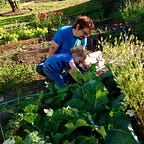I’ll be Home for Solstice
A meditation
Working with plants makes you realize that the whole “Seasonal Holiday” thing makes a lot of sense. You also start getting the feeling that we’ve (meaning Western Culture) never really “abandoned” the healthier animism of our forebears, we’ve only managed to smother it in layers of myth. Lately, for me, stripping the layers away has become more interesting, or viewing our traditional stories as tales about the hidden meanings in natural processes.
At this point in history, any religious tradition that doesn’t address the planet’s ability to feed its inhabitants and the ethical imperative that we do so in a generative fashion is worthless. However, even mainstream spiritual traditions, when re-imagined in an animist context, can provide lessons in this regard.
Take some of the tales we know from the Bible: Noah’s Ark saving not the animals of the world, but the plants, from the seasonal flooding of the rivers. Or, here in the Pacific Northwest, maybe the Flood is the winter deluge, threatening our overwintering gardens. (I, for one, will take the rain over the other option.) Still, it’s telling that Noah had to take two of each animal with him: apparently “God” knew that the plants would survive the flood (thus the olive branch in the dove’s mouth). De facto proof that plants are more sacred than animals, no?
But there’s more: Jesus as the “Spiritual Seed” descending into the dirt of the Underworld, rising from the dead, mirrors the Parable of the Mustard Seed, and has as much power when taken as a literal tale of the magic of agriculture as it does when taken in a “spiritual” fashion. In many ways, this is a Gnostic view of nature spirituality — by discovering the spiritual seed within each of us, we also begin to recognize it in the spirits that surround us, and the salvation of the World we live in becomes the result of the knowledge (gnosis) we’ve gained through working in tandem with the ecosphere, and particiating in our ecology. The Gospel of Thomas states, after all, that the “Kingdom…is spread out over the Earth, but [we] don’t see it.”
In the Zen tradition of Buddhism, there’s a saying that even a blade of grass can become a Buddha.
This coming year, I’ve decided to make Winter Solstice (and the other traditional sun-based holidays) just as important and worth noting as Christmas and Easter and the rest. Or, rather, since there’s so much overlap, to recognize the natural patterns underneath our cultural holidays — in many ways, this is the most ancient spiritual practice.
Beginning with Winter Solstice/Yule/Christmas, consider how the light is affecting the plants and trees around you. What is surviving and thriving? What lies dormant beneath the snow, or (in my case) in the garden?
I’m also going to try to pay more attention to the spirits inherent within the ecosphere, the entities present within each blade of grass that are just as worthy of Buddhahood as we humans (perhaps even moreso!). The overwintering brassicas and garlic and fava beans in my garden are in a kind of stasis, awaiting the Coming of the Light, the awakening of their spirits in spring.
The wild deities of traditional paths enliven the forests, even when placed in totally separate climatic or eco-centric contexts. Trees and birds and animals and the wind and water and air; worshiping these means participating in the environment by moving through the environment and working with the environment. Church becomes the garden, or farm, or a forest path, and the gifts of the spirits become a gallon bag of Hawthorn berries, or a huge harvest of collard greens, or six eggs.
You don’t need special ceremonies, or books of spells, or rituals or prayers to participate in ecology in this fashion. You just need to be present in the world, to read the meaning inherent in the increasing sunlight as time moves forward, to walk through the environment capably, as a participant rather than an observer.
This Solstice (today or tomorrow, depending on who you listen to), the shortest day of the year, if you can do so, go outside and find a plant you can make something with. Maybe it’s a dandelion, maybe it’s an apple, maybe it’s some ivy or some evergreen you can make into a wreath, or some kindling or a log you can make into a fire. Consider the life-force inherent in this plant material, and how when we use it we are exchanging something for it.
Even on the darkest day, when the light is most limited, we receive these spirit-filled gifts we can use and enjoy, and give thanks for.
